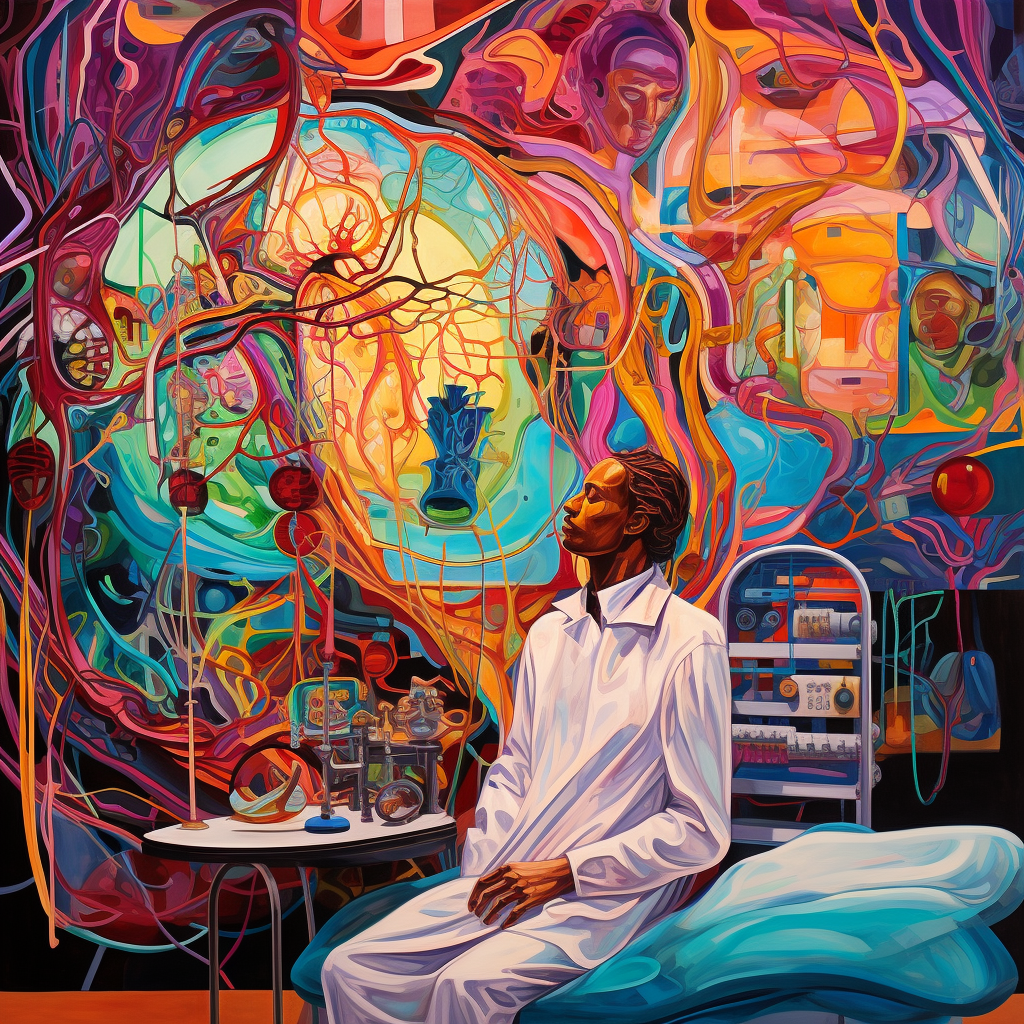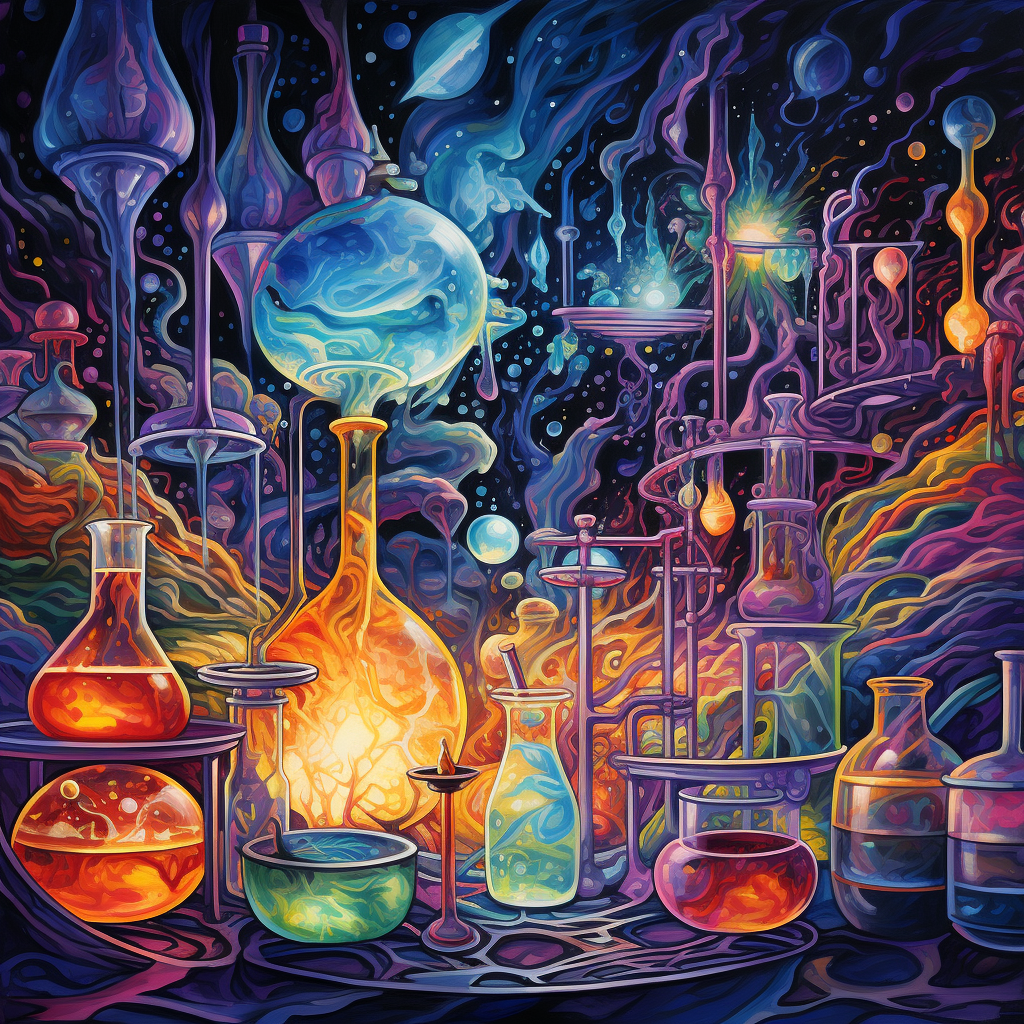We're in Beta 🙃
History and Cultural Significance
Medical Origins
Ketamine was first synthesized in 1962 by scientist Dr. Calvin Stevens, and was initially developed as a safer alternative to the anesthetic phencyclidine (PCP). Its unique properties as a dissociative anesthetic quickly gained recognition in medical circles.
It has became a staple in operating rooms and emergency departments, valued for its ability to induce anesthesia while preserving respiratory function and offering a rapid recovery. Its use in pediatric and veterinary medicine further solidified its role in the medical world.
During the Vietnam War, this substance was the preferred battlefield anesthetic. It provided rapid pain relief to wounded soldiers and could generally be applied safely by soldiers under challenging conditions.
Psychedelic Emergence:
In the late 20th century, ketamine ventured beyond medical confines and found its way into the realm of psychedelics. The substance's dissociative effects and ability to induce altered states of consciousness intrigued a new generation of explorers. Its psychedelic potential, characterized by vivid and immersive experiences, drew attention from psychonauts and researchers alike. It soon became a subject of interest in studies exploring altered states of consciousness and the treatment of mental health conditions.
Ketamine's dual identity, as both a respected anesthetic and a tool for exploring the depths of human consciousness, underscores its complexity and the evolving perspectives on its cultural significance.
The Chemistry of Ketamine
 Ketamine, a versatile compound with a wide range of applications, is chemically known as (RS)-2-(2-Chlorophenyl)-2-(methylamino)cyclohexanone.
Ketamine, a versatile compound with a wide range of applications, is chemically known as (RS)-2-(2-Chlorophenyl)-2-(methylamino)cyclohexanone.
The substance exists in two mirror-image forms, known as enantiomers: the R-enantiomer and the S-enantiomer. These enantiomers have distinct pharmacological properties and effects. The S-enantiomer, often referred to as "esketamine," is commonly used in clinical and medical applications due to its anesthetic and dissociative properties. In contrast, the R-enantiomer has a more limited role in medical practice.
The multifaceted pharmacological actions on the central nervous system are due to its chemical complexity. By interacting with specific receptors and neurotransmitter systems in the brain, ketamine produces a range of effects, including dissociation, analgesia, and, in lower doses, psychedelic experiences. Understanding its chemical structure is a crucial step in comprehending how this multifaceted substance exerts its diverse array of effects on the human mind and body.
How Ketamine Affects Your Brain
Ketamine's remarkable effects on consciousness and perception are rooted in its unique interactions with the brain and nervous system.
NMDA Receptor Modulation: Ketamine primarily operates by antagonizing N-methyl-D-aspartate (NMDA) receptors in the brain. NMDA receptors are essential for synaptic plasticity and the transmission of glutamate, a major excitatory neurotransmitter. Binding to these receptors disrupts normal signaling processes, leading to altered perceptions and a sense of dissociation from one's surroundings.
Glutamate Regulation: This NMDA receptor blockade reduces the overall activity of glutamate in the brain. This decrease contributes to overall effects on cognition and sensory perception. It's important to note that glutamate is a key player in synaptic plasticity, learning, and memory processes.
Induction of Neural Pathways: Ketamine also induces activity in various neural pathways, including the default mode network (DMN). This network is associated with self-referential thinking and mind-wandering. The disruption of DMN activity may explain the altered sense of self and reality often experienced with this substance.
Rapid Onset and Short Duration: One of ketamine's unique pharmacological attributes is its rapid onset of action, with effects becoming noticeable within minutes of administration. This speed of action is attributed to its ability to cross the blood-brain barrier quickly. However, this rapidity is matched by a relatively short duration of effects, which typically last around 30 to 60 minutes.
The Ketamine Experience
Ketamine can usher in an immersive journey marked by dissociative sensations, a sense of detachment, and sometimes profound insights. Its duration can range from 30 minutes to a couple of hours, depending on the dose and route of administration.
As the substance takes effect, individuals often feel a notable disconnection from their physical bodies, creating an expansive mental space that contrasts sharply with their limited physical perceptions.
The voyage is distinct in its texture and quality, characterized by a complex interplay of the drug's pharmacological effects, an individual's psychological landscape, and the surrounding environment.
Although each ketamine experience is unique to the individual, certain recurring themes and sensations have been frequently reported both in clinical settings and recreational contexts:
Dissociative Effects: Users often describe a sensation of floating or being detached from their physical bodies, sometimes perceiving their environment from an outsider's perspective.
Enhanced Inner Vision: Participants might experience vivid mental imagery, often abstract and dreamlike. This can range from simple geometric patterns to more intricate and symbolic narratives or scenarios.
Revisiting Past Experiences: Some users find themselves revisiting past events or moments in their lives, seeing them from new perspectives, which can be therapeutic in addressing unresolved issues.
Sense of Tranquility: Despite its dissociative nature, ketamine can instill feelings of serenity and peacefulness. This calm detachment often allows for introspection without the emotional intensity that might be felt in a sober state.
Temporal Fluidity: As with many psychedelics, this substance can distort one's perception of time. Minutes might feel extended, providing a spaciousness that allows for contemplation and inner exploration.
Encounters with the Subconscious: While not as common as with some other psychedelics, certain users have reported interactions with archetypal figures or manifestations of their subconscious mind during deeper ketamine journeys. These encounters can provide clarity and understanding on personal issues or internal conflicts.
The ketamine experience can be described as...
My whole feeling of my body disappeared…. It was like being an amoeba and just floating in space. I had nobody, I had no- I was a soul...
Sometimes it would become very linear, everything will be at right angles and lines and squares. And other times it would be just like a blur it would just be colours. And it would constantly change and evolve, what I was seeing would evolve and what I was hearing would evolve as well
It was about material things, not wanting those, those aren't really important. And neither is the sense of doubt and self-criticism, you know, it's almost like life's too short.
And so essentially, it was like this higher power, this representation of the higher power [referring to God] that had appeared at the start was showing that I had permission to be happy and do I what want, as long as I didn't misuse my resources
Can Ketamine Therapy Help with Severe Mental Health Conditions?
Clinical studies and ongoing research have shown promising results across various disorders, offering new hope for those who have found little relief from conventional treatments.Depression
Ketamine's unique mechanism of action involves the modulation of glutamate receptors in the brain, which can rapidly alleviate depressive symptoms. It is particularly promising for treatment-resistant depression, where traditional treatments often fall short.
A study published in the Indian Journal of Psychiatry (2019) demonstrated that ketamine infusion therapy led to significant reductions in depressive symptoms in individuals with treatment-resistant depression, with effects observed within hours to days.
Anxiety
Ketamine's ability to induce a dissociative state can provide relief to individuals with severe anxiety disorders. It may also promote neuroplasticity, helping the brain adapt to reduce anxiety over time.
While more research is needed, preliminary studies have indicated potential benefits for anxiety disorders.
Post-Traumatic Stress Disorder (PTSD)
Ongoing clinical trials are exploring ketamine's role in the treatment of PTSD. While results are pending, here is one look at the possible benefits and mechanisms of action according to several MDs.
Obsessive-Compulsive Disorder (OCD)
Ketamine's impact on glutamate receptors may play a role in disrupting obsessive thought patterns.
Preliminary research, such as a study in the Journal of Affective Disorders (2020), suggests that ketamine may have potential benefits for individuals with treatment-resistant OCD. However, further investigation is required.
It's essential to note that while ketamine therapy shows promise, it is not a standalone treatment for severe mental health conditions. Medical professionals recommend that it be administered under professional supervision and integrated into a comprehensive treatment plan, often involving psychotherapy or other integrative facilitation and ongoing support.
On February 16, 2022, the FDA published a compounding risk alert describing the potential risks associated with at-home use of compounded ketamine products. The risk alert recommends that any use of compounded ketamine be done in a clinically supervised environment so that a health care provider can monitor for sedation (sleepiness), dissociation, and changes in vital signs that may indicate adverse reactions.
What does the FDA mean by compounded ketamine? As we mentioned in our chemistry section above, ketamine consists of two mirror-image molecules, known as R-ketamine and S-ketamine (or arketamine and esketamine, respectively).
Spravato, a product that contains only the esketamine molecule, has received FDA approval. It is prescribed for adults dealing with Treatment-Resistant Depression (TRD) or Major depressive disorder (MDD), as well as for adults dealing with acute suicidal thoughts or behavior (and to be used alongside an oral antidepressant).
✨ Benefits + Effects of Ketamine ✨


Dissociation &


Altered


Enhanced


Improve Mental


Pain


Spiritual &
The Latest Scientific Research on Ketamine
Ketamine Found Effective For Severe Treatment-Resistant Depression
In a groundbreaking clinical trial involving 403 patients, and recently published in June 2023, 55% of those treated with ketamine experienced sustained relief from depressive symptoms without significant memory loss or other side effects.This is compared to 41% of those treated wth electroconvulsive therapy (ECT).
The study compared ketamine to ECT for non-psychotic, treatment-resistant depression and is the largest study of its kind. ECT, a traditional treatment for major depression, can lead to memory loss and carries social stigma.
“For the ever-growing number of patients who do not respond to conventional psychiatric treatments and need a higher level of care, ECT continues to be the most effective treatment in treatment-resistant depression,” said psychiatrist Murat Altinay, lead of the trial site at Cleveland Clinic. “This study shows us that intravenous ketamine was non-inferior to ECT for treatment of nonpsychotic treatment resistant depression and could be considered as a suitable alternative treatment for the condition.”
A Meta-Analysis of Ketamine Treatment in Unipolar & Bipolar Depression
In a meta-analysis published in April 2020, researchers analyzed 20 randomized clinical trials on ketamine's efficacy in treating major depression. The largest effect was seen 24 hours post-administration, with a significant reduction in depressive symptoms.
This effect persisted for up to 7 days after a single dose. Notably, ketamine's continued effects at the 7 day mark only occurred when ketamine was paired with ongoing antidepressent treatment. As a monotherapy, ketamine did not demonstrate significant difference in treatment resistant patients at the 7 day mark compared to control.
Repeated administration proved effective in sustaining initial antidepressant effects. A significant reduction in depression severity scores was observed at 2–3 weeks of repeated treatment.
Can ketamine trigger a bad trip?
In clinical settings, ketamine therapy is typically administered under the guidance of trained professionals, significantly reducing the likelihood of a "bad trip" compared to recreational or unsupervised use. However, some individuals may still experience distressing or uncomfortable sensations.
A bad trip can include:
- Intense hallucinations that are emotionally distressing.
- Confusion or disorientation.
- Anxiety or panic.
- Feelings of detachment or loss of control.
- Nausea or vomiting.
Other possible side-effects
Ketamine therapy, like any medical treatment, carries the potential for side effects. These can vary from person to person and may include:
- Dissociation: The sensation of being detached from one's body or surroundings, which is often an intended effect in therapy but may be unsettling for some.
- Nausea and Vomiting: Especially when administered in higher doses.
- Temporary Increase in Blood Pressure and Heart Rate: This is typically monitored by healthcare professionals during the session.
- Potential for Psychological Distress: In some cases, therapeutic use of this substance can bring repressed memories or emotions to the surface, leading to temporary distress.
- Resurgence of Symptoms: After a session, some individuals may experience a brief resurgence of their symptoms before experiencing longer-term improvements.
Such risks and side effects are typically managed and mitigated by the healthcare team overseeing treatment. Be sure you are carefully screened, monitored, and supported throughout the process when seeking ketamine therapy.
Contraindications for Use
While ketamine is considered relatively safe when administered by trained medical professionals, there are certain contraindications and precautions to be aware of:
- Hypersensitivity: Individuals who have a known hypersensitivity or allergy to ketamine should avoid its use. Allergic reactions can range from mild skin rashes to severe anaphylactic reactions.
- Uncontrolled Hypertension: This substance may transiently increase blood pressure and heart rate. Individuals with uncontrolled hypertension or a history of cardiovascular issues should exercise caution and consult with a healthcare provider before using ketamine.
- Severe Liver or Kidney Disease: Ketamine is metabolized in the liver and excreted by the kidneys. Severe liver or kidney impairment can affect the body's ability to clear the substance out. Those with such conditions should discuss the risks and benefits with a medical professional.
- History of Psychosis or Mania: Ketamine can induce hallucinations and altered perceptions, which may exacerbate symptoms in individuals with a history of psychosis or mania. Careful assessment and supervision are crucial in such cases.
- Substance Use Disorders: Individuals with a history of substance use disorders, particularly those involving substances with addictive potential, should use this substance cautiously. Ketamine itself has the potential for misuse, and its use should be closely monitored.
- Pregnancy and Breastfeeding: Limited research is available on the effects of ketamine during pregnancy and while breastfeeding. Pregnant or nursing individuals should consult with healthcare providers to assess potential risks.
- Medication Interactions: This psychedelic may interact with certain medications, including central nervous system depressants, stimulants, and monoamine oxidase inhibitors (MAOIs). Inform your healthcare provider of all medications you are taking to avoid potential interactions.
- Age Considerations: Individuals may experience different effects and tolerances depending on age. Pediatric and geriatric populations should be carefully evaluated by healthcare professionals before use.
The Legal Status of Ketamine
Federal Status in the United States
Ketamine is classified as a Schedule III controlled substance under the United States federal law, and is subject to strict regulation. Any unauthorized possession, distribution, or trafficking can lead to severe legal consequences, including fines and imprisonment.
Schedule III substances are considered to have a moderate to low potential for physical and psychological dependence, relative to Schedule I and II substances.
In recent years, ketamine has gained attention for its potential therapeutic applications in mental health, particularly for treatment-resistant depression and certain anxiety disorders. Clinicians may use it off-label in a clinical setting for these purposes.
Some municipalities and states in the United States have taken steps to decriminalize or reduce penalties for the possession and use of psychedelics, including ketamine, for personal use. These initiatives vary by location and may not change the federal legal status.


International Legal Status
Beyond the United States, the legal status of ketamine varies from one country to another. While ketamine is considered a controlled substance in many countries, particular regulations vary. For instance:
-
United Kingdom: In the United Kingdom, Ketamine is classified as a Class B drug under the Misuse of Drugs Act 1971. Possession, production, and supply of Ketamine without proper authorization are illegal. Medical professionals may use Ketamine as an anesthetic.
-
Canada: Canada classifies Ketamine as a Schedule III controlled substance under the Controlled Drugs and Substances Act. Authorized medical professionals can prescribe Ketamine for medical purposes.
-
Australia: In Australia, Ketamine is listed as a Schedule 8 controlled substance under the Poisons Standard. Its use is primarily restricted to medical and veterinary settings.















